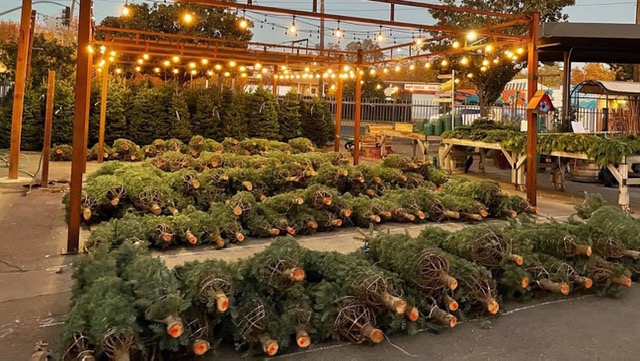
While artificial trees are caught in transit, real trees are ready for customers

|
| Area nurseries and home improvement stores, plus pop-up sellers, will have stock of live Christmas trees. The Plant Foundry, above, in Oak Park received its trees early in the week and the staff members were setting them up as fast as they could. (Photo courtesy The Plant Foundry) |
Will there be a Christmas tree shortage this holiday season? No – if you keep it real.
While artificial trees may be stuck in supply chain snags, real trees should be in good supply, according to the National Christmas Tree Association.
In particular, trees should be in good shape and in good supply from El Dorado County growers. After months of drought, October rain refreshed the pines, firs and cedars. They’re now ready for cutting and customers.
Clustered around Placerville in the Apple Hill area, local growers traditionally open their farms to visitors the day after Thanksgiving and keep selling until sold out. Challenged by drought and pandemic, some family farms have stopped selling trees, but about 20 El Dorado County growers are expected to be offering trees this season. For a map, details and directions, got to https://chooseandcut.com/ .
City shoppers also should find a healthy selection of fresh trees, says the national association, but shop early. The lack of fake tree availability is driving more demand for the real thing.
An intense summer heat wave did sunburn lots of Oregon-grown trees, causing concern, say industry experts. Farms in the northern Willamette Valley reported many heat-related losses. Fortunately, the sunburn was often only cosmetic and could be trimmed off.
Looking for a Christmas tree near you? Check out the tree locator map (and tree tips) at: www.itschristmaskeepitreal.com .
What about a potted living tree? Firs, pines and other conifers are not houseplants; it’s best if these trees’ days indoors are numbered.
If you decide to use a living Christmas tree, keep it outside in a sunny location and well-watered until Christmas week. This reduces stress on the young tree. Make its stay indoors as brief as possible before returning outside – and hopefully finding a spot where it can put its roots down.
Comments
0 comments have been posted.Sacramento Digs Gardening to your inbox.
Sites We Like
Garden Checklist for week of July 21
Your garden needs you!
* Keep your vegetable garden watered, mulched and weeded. Water before 8 a.m. to reduce the chance of fungal infection and to conserve moisture.
* Feed vegetable plants bone meal, rock phosphate or other fertilizers high in phosphate to stimulate more blooms and fruiting. (But wait until daily high temperatures drop out of the 100s.)
* Don’t let tomatoes wilt or dry out completely. Give tomatoes a deep watering two to three times a week.
* Harvest vegetables promptly to encourage plants to produce more. Squash especially tends to grow rapidly in hot weather. Keep an eye on zucchini.
* Pinch back chrysanthemums for bushy plants and more flowers in September.
* Remove spent flowers from roses, daylilies and other bloomers as they finish flowering.
* Pinch off blooms from basil so the plant will grow more leaves.
* Cut back lavender after flowering to promote a second bloom.
* It's not too late to add a splash of color. Plant petunias, snapdragons, zinnias and marigolds.
* From seed, plant corn, pumpkins, radishes, winter squash and sunflowers.